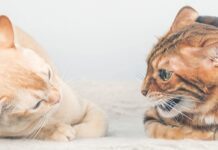Fun With Feline Tooth Brushing
Few cat lovers would deny the importance of regular veterinary dental care for the cats with whom they share their lives, but a recent article in the journal Veterinary Medicine (Vol. 98 Issue 2) emphasizes home care, too – though the author admits that delivering it isnt always easy.
Writing about Dental prophylaxis: Examination, cleaning and home care, Florida-based veterinary dentist R. Michael Peak, DVM, says that professional care of cats teeth is only half the equation. He recommends daily brushing to remove the plaque-like glycoprotein layer – called pellicle – that starts to form within minutes after a professional cleaning.
In the mother of all understatements, Peak goes on to say: The drawbacks are client compliance and patient acceptance. He adds that creating a fun and rewarding experience for the cat may make life a little easier.
Peak does offer some hints, such as finding a flavored feline toothpaste the cat likes and, for the first several days, offering a sample as a reward or treat. Simulate the motion of a toothbrush with the toothpaste treat on an index finger, he suggests. Praise the pet. With the toothpaste treat as an inducement, he says, the cat should eventually accept the following: Position the bristles at a 45-degree angle to the surface of the teeth and make small, circular strokes at the gum line while rotating the bristles outward to remove debris. Eight to 10 strokes are usually sufficient for a given area, says Peak, who suggests a way to prop a cats mouth open during brushing. Simply insert a cat toy, he advises.
Obsessing Over Cat Compulsions
Compared to dogs and the wacky things they do under stress, cats with OCD (obsessive-compulsive disorder) are nearly normal – or so some cat owners claim. While not trivializing OCD in cats, a recent article in the Journal of the American Veterinary Medical Association (Vol. 221, No. 10) confirms that OCD dogs (and their worried owners) can be in for a wild ride.
The ritualistic, stereotypic behaviors of OCD dogs can include circling, tail chasing, flank sucking, fence running, fly biting, self mutilation, hair or air biting, pacing or spinning, staring, self-directed vocalizing and fabric sucking or chewing, according to the article, titled Clinical features and outcome in dogs and cats with obsessive-compulsive disorder.
Cats will engage in fabric sucking and chewing, too, as owners of some Siamese cats can attest. After that, cats OCD repertoire is pretty much limited to excessive grooming and some self mutilation and tail chasing, the article authors report, then add this diagnostic caveat: Because behaviors seen in OCD are often normal behaviors performed in an inappropriate, excessive, or out-of-context manner, history becomes particularly important in elucidating whether the patient truly has OCD.
Rather than jumping to conclusions (a common compulsion among humans), cat owners and their veterinarians should first consider other possible causes for the pets stereotypic behavior, the journal authors suggest. OCD-like behavior may have a medical cause, like an itchy skin disease or an environmental one, citing understimulation, neglect, excessive confinement, and separation anxiety as potential causes.
And if true OCD is diagnosed, the authors said that treatment with medication (such as clomipramine) and behavior modification is usually extremely successful.



